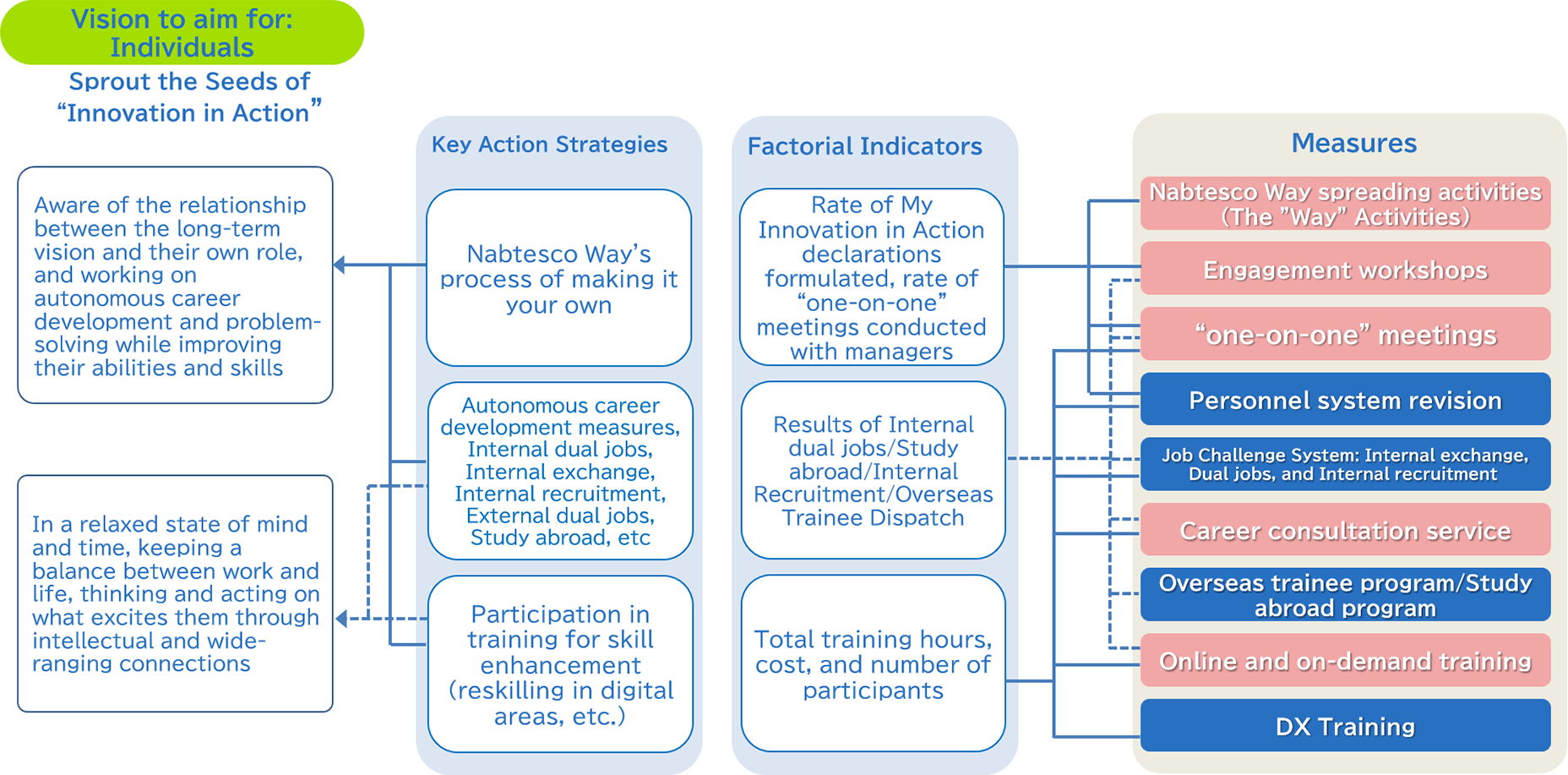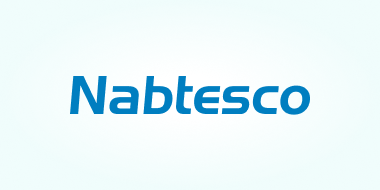
The Optimization of Human Capital
Story of Enhancing Corporate Value through the Optimization of Human Capital
Under the slogan, “Leaders in Innovation,” as upheld in its long-term vision, Nabtesco has been striving to increase its corporate value, with a focus on meeting customer needs and exceeding the expectations of both customers and society alike. This effort carries on a long tradition dating back not only to the Company’s founding but also to the aims of its two predecessor companies prior to their integration. Toward this goal, we are striving to enhance both our financial impact and social impact by boosting our performance and contributing to the solution of social challenges.
To this end, we need to enhance our existing businesses while also searching for new businesses, as proposed in the theory of organizational ambidexterity. To meet this requirement, we must foster reforms for the various categories of capital that provide us with a foundation for innovation. In particular, human capital is essential for our value creation process, and Nabtesco accordingly aims to manage and optimize its human capital toward becoming “Leaders in Innovation.”
In order to “meet” the expectations of customers, we need personnel who are strongly committed to meeting the needs of customers through unyielding technological innovation, performance & quality improvement and higher productivity. To take the next step of then exceeding the expectations of customers and society, we need to develop and attract personnel who can expand our existing business domains and launch new businesses to create and propose expectation-exceeding value.
As an organization, we also need to gain the ability to respond agilely to changes in our business environment. To this end, managers are required to play important roles to encourage individual employees to take actions autonomously and independently and to serve as an intermediary to foster not only traditional top-down measures taken under the leadership of top management but also bottom-up measures taken at the initiative of general employees. Nabtesco’s human capital management is thus based on measures promoted by the three actors: top management, middle managers, and individual employees. Nabtesco will proactively make investments to support these three actors in fulfilling their respective roles and will strongly repeat the cycle of meeting and exceeding the expectations of customers and society toward the achievement of its long-term vision.
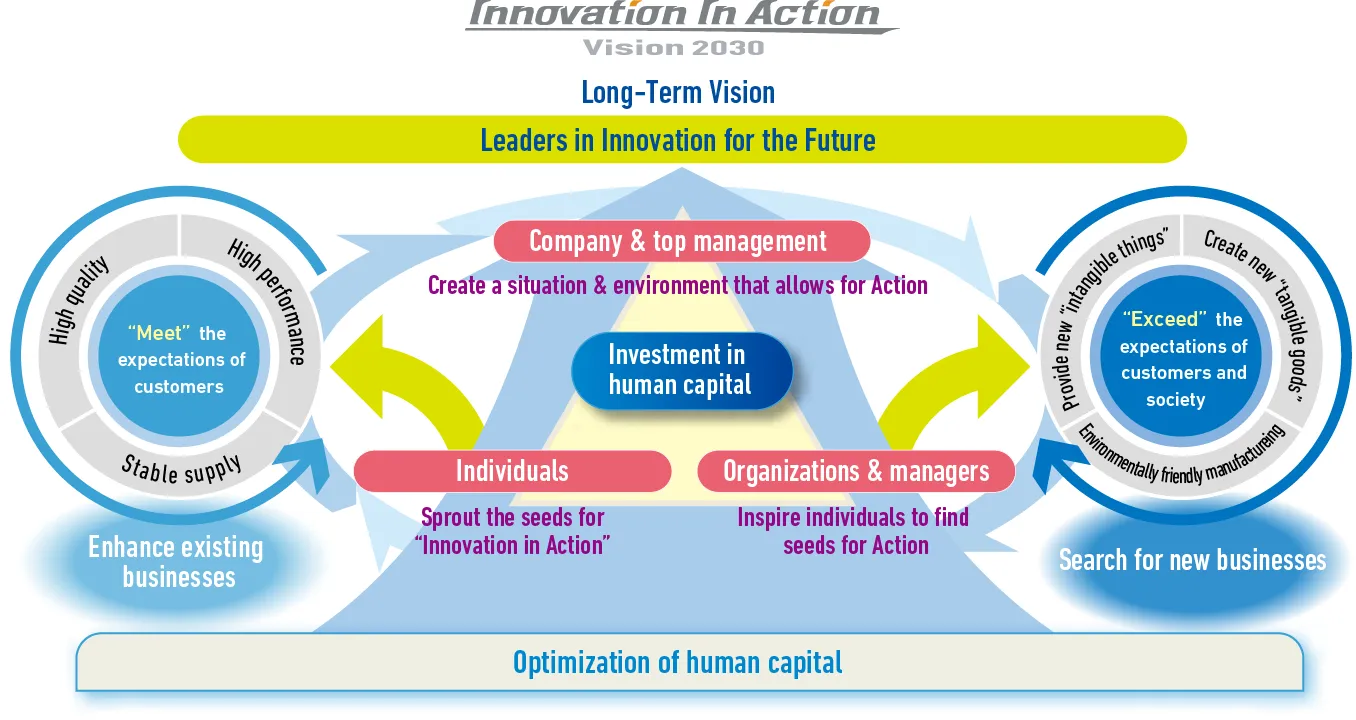
Vision for Human Capital Management
Nabtesco believes that the creation of new value will be promoted by the fulfillment of defined roles by the company & top management, organizations & managers, and individual employees. Based on this recognition, we have set a vision for each of the above for the optimization of human capital.
The role of the company & top management is to create a situation & environment that allows for Action. The role of organizations & managers is to inspire individuals to find seeds for Action. The role of individual employees is to sprout those seeds for “Innovation in Action.” Nabtesco upholds this vision for its human capital management.
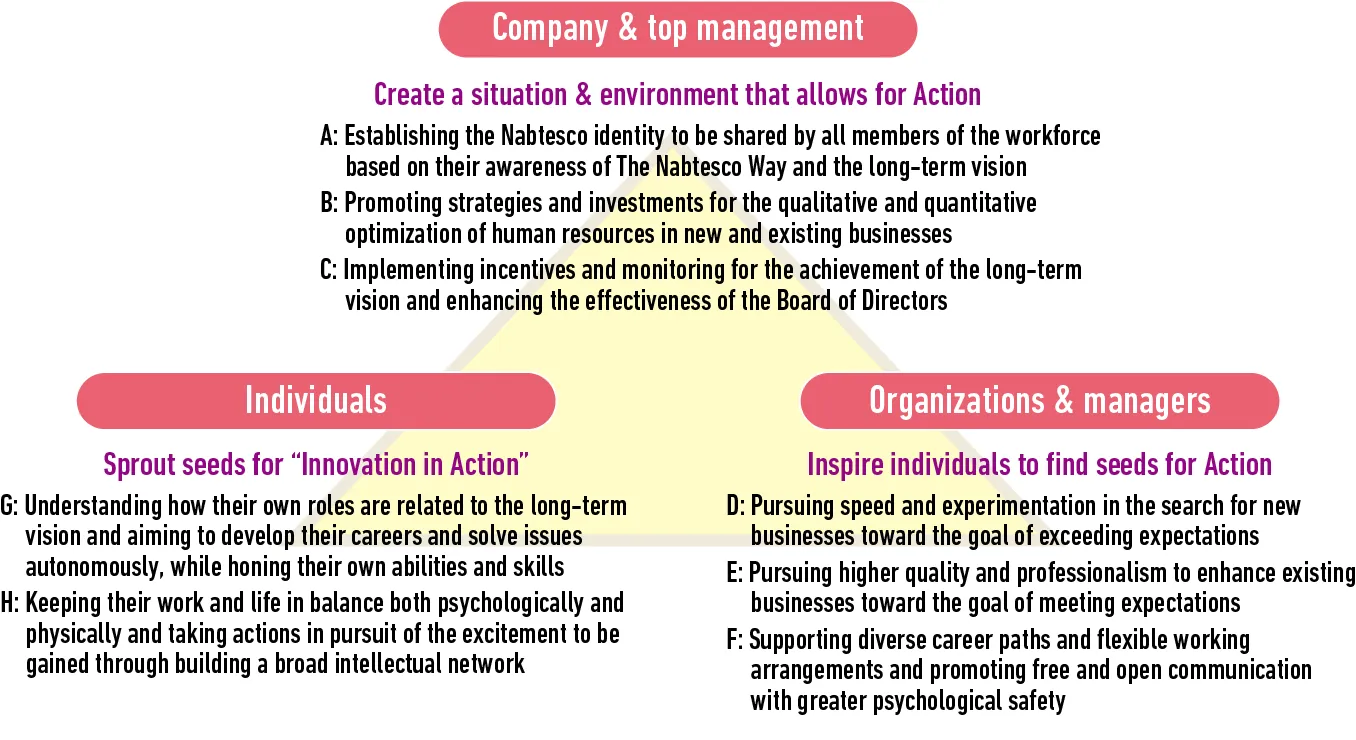
Gaps between Reality and Vision: Identification of Issues
Nabtesco regularly conducts an employee engagement & organizational diagnosis survey to grasp employees’ subjective ideas based on their engagement scores (ES) and clarify the present situation from the viewpoint of individuals and organizational culture.
When designing the questionnaire for organizational diagnosis, we first set “innovation items” that are thought to be highly related to challenges, co-creation,
learning and creativity—elements that help foster innovation. We then classified the questions into those related to individuals (individuals’ indicators) and those related to the organization (organizational indicators). For these two types of indicators, we analyzed the survey results with a focus on correlations between the sufficiency rating given to each of the question items, including both innovation items and others, and the item’s connection to innovation.
The graph shown below indicates the level of each item’s connection to innovation (horizontal axis) and its sufficiency rating (vertical axis).
The items shown on the lower right side of the two graphs are items that are strongly connected to innovation but for which the sufficiency rating is low. For the organizational indicators, the survey results imply that a driving force for innovation would be “Outlook for the achievement of targets,” “Identification of social changes by the company ahead of others” and “Creation of a culture of embracing challenges” for the company & top management; and “Solution of issues across the departments” and “Development of the next generation of leaders” for organizations & managers.
As for individuals, the key items include individual employees feeling satisfied with their jobs and able to feel a sense of achievement and self-growth. Based on the survey results, we have formulated a hypothesis that the fulfillment of these items will be a priority issue in creating innovation leaders. We are now promoting measures to close the gaps between these indicators and reality through a three-way collaboration among the company & top management, organizations & managers, and individual employees.
Individuals’ indicators and innovation
Organizational indicators and innovation
Key performance indicators (KPIs) for human capital
Nabtesco has established the “Innovation Index,” “Linkage Index,” and “Engagement Index” as its human capital KPIs. These are synthetic indicators combining organizational diagnostics and engagement surveys to assess the progress and outcomes of human capital management initiatives. By identifying key priorities from each KPI's components and linking them to specific initiatives, we enhance individual employee growth and team collaboration, and continuously drive improvement in overall organizational performance.
Progress of KPIs for human capital
[Company & top management]
Innovation index
[Organizations & managers]
Linkage index
[Individuals]
Engagement index
In FY2024, all human capital KPIs improved by one point compared to the previous year.
The Innovation Index rose by one point year-on-year as positive responses increased in questions regarding individuals’ willingness to take on challenges and engage in learning to enhance their expertise. The Linkage Index also saw an increase of one point year-on-year, driven by improvements in key focus areas such as “Outlook for the achievement of the corporate targets for the fiscal year” and “Solution of issues across departments.” On the other hand, the eNPS (an indicator showing whether employees would recommend their workplace to close friends or family) has declined, showing that efforts to instill our philosophy and strategy are still insufficient. We recognize the need to advance initiatives that enhance pride and trust in the company and its businesses. These efforts will center on town hall meetings led by top management, which began this year; activities to promote the Nabtesco Way; and communication of our philosophy and strategy through the company newsletter. As for the Engagement Index, scores for all key focus areas— “Growth opportunities,” “Motivation,” “Sense of achievement,” and “Acknowledgement for achievements”—increased, resulting in a one-point rise year-on-year. Communication between managers and subordinates is becoming more active, and daily feedback and evaluation systems are beginning to function more effectively. We believe an environment where each employee can better experience their growth and achievements is steadily taking shape. However, we recognize that the level of fulfillment for each item has not yet reached a sufficient standard, and it remains important to continue examining and implementing specific measures corresponding to each item.
[Company & top management] Innovation index
Systematic measures to improve the Innovation Index
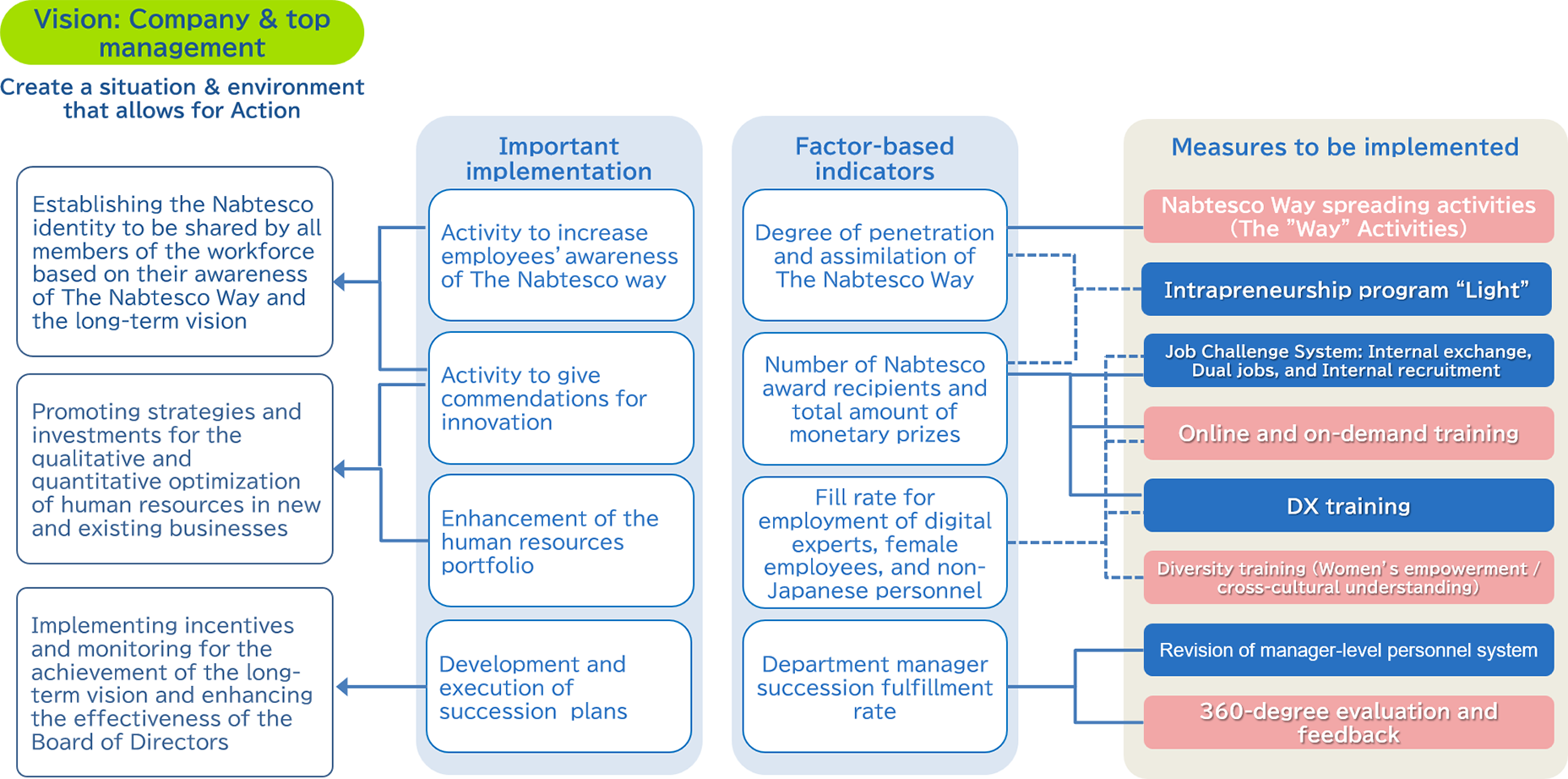
[Organizations & managers] Linkage index
Systematic measures to improve the Linkage Index
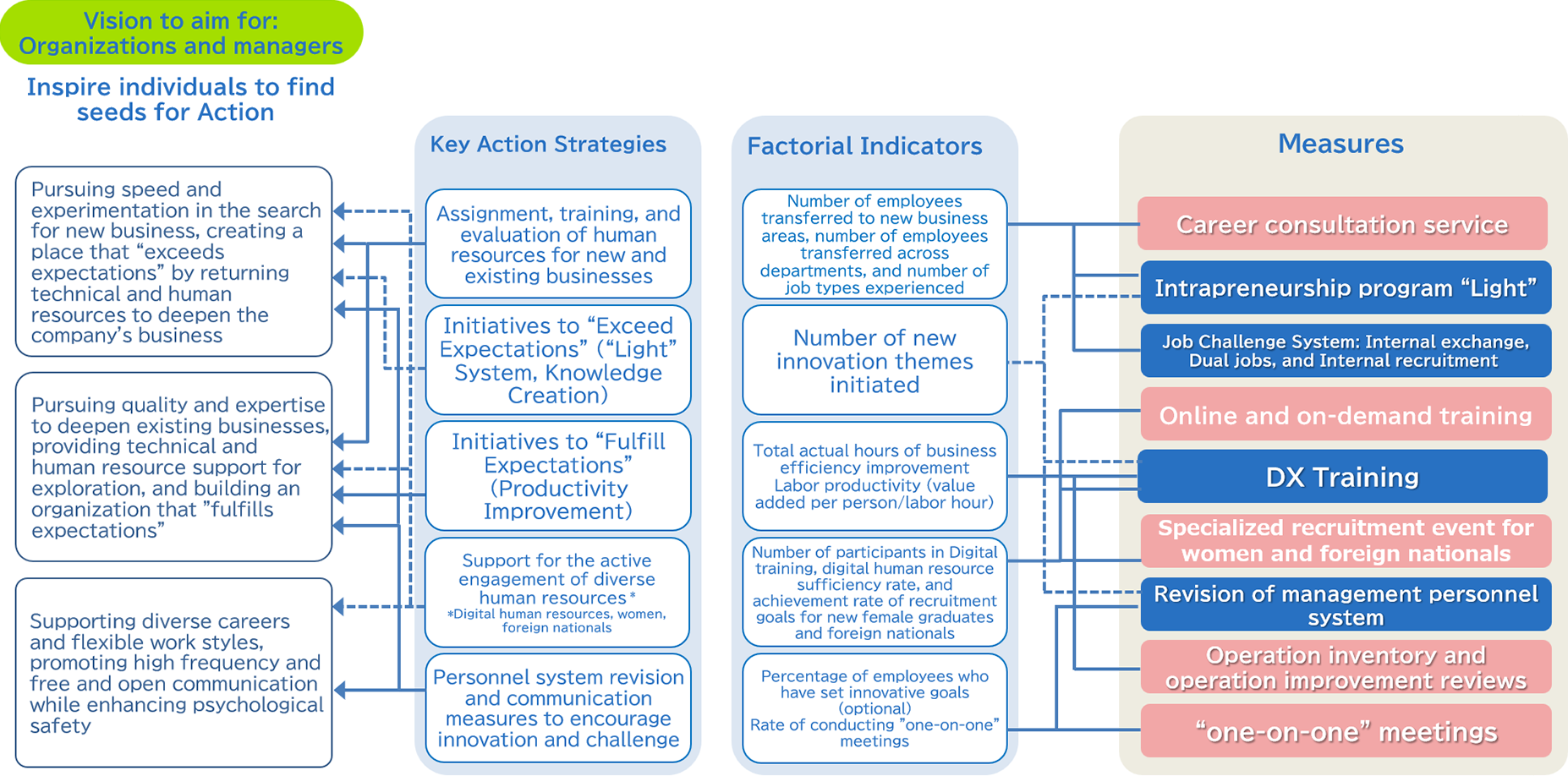
[Individuals] Engagement index
Systematic measures to improve the Engagement Index
